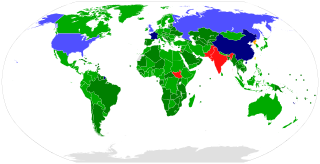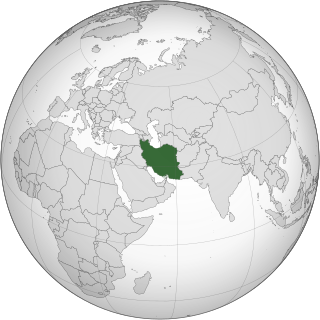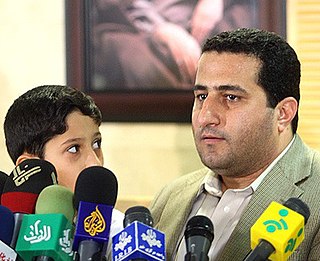| |||||
| Decades: | |||||
|---|---|---|---|---|---|
| See also: | Other events of 1959 Years in Iran | ||||
The following lists events that happened during 1959 in the Imperial State of Iran.
| |||||
| Decades: | |||||
|---|---|---|---|---|---|
| See also: | Other events of 1959 Years in Iran | ||||
The following lists events that happened during 1959 in the Imperial State of Iran.
Establishment of Tehran Nuclear Research Center (TNRC). [1]

The Treaty on the Non-Proliferation of Nuclear Weapons, commonly known as the Non-Proliferation Treaty or NPT, is an international treaty whose objective is to prevent the spread of nuclear weapons and weapons technology, to promote cooperation in the peaceful uses of nuclear energy, and to further the goal of achieving nuclear disarmament and general and complete disarmament. Between 1965 and 1968, the treaty was negotiated by the Eighteen Nation Committee on Disarmament, a United Nations-sponsored organization based in Geneva, Switzerland.
Iran has research sites, two uranium mines, a research reactor, and uranium processing facilities that include three known uranium enrichment plants.

Natanz is a city in the Central District of Natanz County, Isfahan province, Iran, serving as capital of both the county and the district. It is 70 kilometres (43 mi) south-east of Kashan.

Iran is not known to currently possess weapons of mass destruction (WMD) and has signed treaties repudiating the possession of WMD including the Biological Weapons Convention, the Chemical Weapons Convention, and the Non-Proliferation Treaty (NPT). Iran has first-hand knowledge of WMD effects—over 100,000 Iranian troops and civilians were victims of chemical weapons during the 1980s Iran–Iraq War.

The relations between Iran and Israel are divided into four major phases: the ambivalent period from 1947 to 1953, the friendly period during the era of the Pahlavi dynasty from 1953 to 1979, the worsening period following the Iranian Revolution from 1979 to 1990, and the ongoing period of open hostility since the end of the Gulf War in 1991. In 1947, Iran was among 13 countries that voted against the United Nations Partition Plan for the British Mandate of Palestine. Two years later, Iran also voted against Israel's admission to the United Nations.
Operation Merlin was a United States covert operation under the Clinton Administration to provide Iran with a flawed design for a component of a nuclear weapon ostensibly in order to delay the alleged Iranian nuclear weapons program, or to frame Iran.

United Nations Security Council Resolution 1747 was a United Nations Security Council resolution, written with reference to some IAEA reports, that tightened the sanctions imposed on Iran in connection with the Iranian nuclear program. It was adopted unanimously by the United Nations Security Council on 24 March 2007.
This is the timeline of the nuclear program of Iran.

The Bushehr Nuclear Power Plant is a nuclear power plant in Iran 1,200 kilometres (750 mi) south of Tehran, between the fishing villages of Halileh and Bandargeh along the Persian Gulf.

Ali Akbar Salehi is an Iranian academic, diplomat and former head of the Atomic Energy Organization of Iran, who served in this position from 2009 to 2010 and also from 2013 to 2021. He served for the first time as head of the AEOI from 2009 to 2010 and was appointed to the post for a second time on 16 August 2013. Before the appointment of his latter position, he was foreign affairs minister from 2010 to 2013. He was also the Iranian representative in the International Atomic Energy Agency from 1998 to 2003.

The P5+1 refers to the UN Security Council's five permanent members ; namely China, France, Russia, the United Kingdom, and the United States; plus Germany. The P5+1 is often referred to as the E3+3 by European countries. It is a group of six world powers which, in 2006, joined together in diplomatic efforts with Iran with regard to its nuclear program.

Shahram Amiri was an Iranian nuclear scientist who disappeared from Iran during 2009–2010 under disputed circumstances, and was executed by the Iranian government in August 2016.
There have been a number of international sanctions against Iran imposed by a number of countries, especially the United States, and international entities. Iran was the most sanctioned country in the world until it was surpassed by Russia, following Russia's invasion of neighboring Ukraine in February 2022.
The Darkhovin Nuclear Power Plant is a planned nuclear power plant located in Khuzestan province, Iran about 70 kilometers south of Ahvaz at the Karun river. Construction of one reactor has started. Some other projects on this site were cancelled. It's built by Masna.

The Joint Comprehensive Plan of Action, commonly known as the Iran nuclear deal or Iran deal, is an agreement on the Iranian nuclear program reached in Vienna on 14 July 2015, between Iran and the P5+1 together with the European Union.

The Iran nuclear deal framework was a preliminary framework agreement reached in 2015 between the Islamic Republic of Iran and a group of world powers: the P5+1 and the European Union.

This article discusses the negotiations between the P5+1 and Iran that led to the Joint Comprehensive Plan of Action.
Between 2010 and 2020, five Iranian nuclear scientists were killed in foreign-linked assassinations. Rezaeinejad was shot dead by gunmen on motorcycles, while Shahriari and Ahmadi Roshan were killed by explosives attached to their cars. Fereydoon Abbasi was also targeted in a car bombing, but survived.

The Joint Comprehensive Plan of Action, more commonly known as the Iran nuclear deal, was the international agreement reached on Iran's nuclear program in Vienna in 2015. The deal, made after several years of negotiation, set in place strict guidelines to regulate and oversee the Iranian nuclear program including the reduction of centrifuges, enriched uranium stockpiles, and an agreement to allow regular inspections of nuclear sites, among other aspects. The deal has attracted enormous criticism by certain political and media elements in the United States and Iran as the deal is viewed as conciliatory in nature by some factions in both countries. For example, President Donald J. Trump called the Iran deal, "the worst deal ever negotiated" and United States Senate Majority Leader Mitch McConnell characterized it as "flawed", while hardliners in Iran have indicated a desire to subvert it. Much of the criticism in the United States has been centered on the issue of appeasement and Iran's compliance, while in Iran many of the criticisms revolve around the issue of sovereignty and non-nuclear restrictions.
2021 Natanz Incident refers to a suspected attack on the Natanz nuclear site in Iran. The Natanz nuclear facility is located in the wilderness of the province of Isfahan, in central Iran. This site is scouted by the International Atomic Energy Agency (IAEA), the U.N. nuclear watchdog.